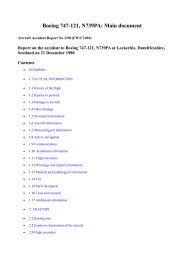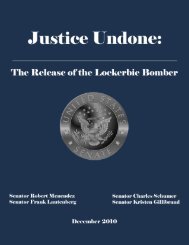REPORT OF THE - Archives - Syracuse University
REPORT OF THE - Archives - Syracuse University
REPORT OF THE - Archives - Syracuse University
Create successful ePaper yourself
Turn your PDF publications into a flip-book with our unique Google optimized e-Paper software.
the Commission as a "daily check list" mentality at the FAA and what the General<br />
Accounting Office had identified over several years as the FAA's purely "reactive"<br />
attitude.<br />
Although the FAA has had procedures to identify problems, those procedures tend to<br />
limit inspectors solely to the items set forth on their "check list." More significantly, the<br />
FAA appears to have had no mechanism to audit a pattern of those problems or to<br />
anticipate problems and solve them before disaster occurs.<br />
Pan Am operations, found to be minimally satisfactory in October 1988, were the subject<br />
of a proposed $630,000 fine after an investigation beginning in December 1988. Those<br />
same operations were assessed as "very poor" in January 1989 but checked off as<br />
"satisfactory" in February, only to be found "totally unsatisfactory" in May 1989.<br />
The destruction of Flight 103 and its horrible loss of innocent lives is a reality. The<br />
potential for terrorist sabotage of another aircraft cannot be eliminated entirely. The<br />
apparent lack of priority placed on this problem by the carrier and the lack of action by<br />
the FAA in enforcing its own standards, however, are lapses that must not recur.<br />
[PICTURE NOT INCLUDED]<br />
The United Kingdom Air Accidents Investigation Board has reconstructed a major<br />
portion of the fuselage of Pan Am Flight 103. This is the end section showing the lower<br />
baggage hold and the passenger deck of the doomed airliner.<br />
The attitude that prevailed both before and after Flight 103 must be changed permanently.<br />
The initiative shown by the new FAA Administrator in September 1989 is a good step in<br />
the right direction. However, as discussed elsewhere in this Report, much more remains<br />
to be done.<br />
CHAPTER 3<br />
<strong>THE</strong> AVIATION SECURITY SYSTEM<br />
Overview<br />
Created in 1958, the Federal Aviation Administration is responsible for ensuring the<br />
safety of air travel. As part of that mission, the FAA Office of Civil Aviation Security<br />
establishes security requirements, inspects airline and airport security operations and<br />
issues civil penalties for noncompliance with those requirements. Security at foreign<br />
airports is provided primarily by the host country. At selected, high risk airports, the FAA<br />
required U.S. air carriers to conduct security procedures that go beyond the host country's<br />
requirements. For domestic airports, security is a joint effort between the air carriers and<br />
the airport operators.<br />
In 1961, the first hijacking of an American flag carrier occurred in the United States. The<br />
domestic aviation security system that has evolved since that date has been partially<br />
effective in meeting this hijacking threat. There were two hijackings of U.S. aircraft in<br />
both 1988 and 1989, the lowest number since 1976.<br />
FAA's role in aviation security expanded significantly in 1985 with passage of Public<br />
Law 99-83, the International Security and Development Cooperation Act. The Act










